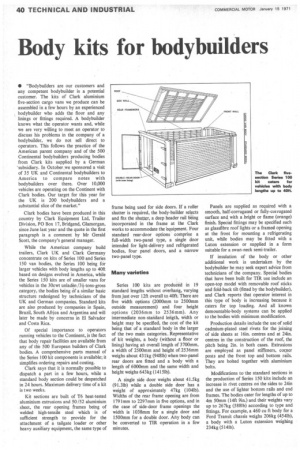Body kits for bodybuilders
Page 42

If you've noticed an error in this article please click here to report it so we can fix it.
• "Bodybuilders are our customers and any competent bodybuilder is a potential customer. The kits of Clark aluminium five-section cargo vans we produce can be assembled in a few hours by an experienced bodybuilder who adds the floor and any linings or fittings required. A bodybuilder knows what the operator wants and, while we are very willing to meet an operator to discuss his problems in the company of a bodybuilder, we do not sell direct to operators. This follows the practice of the American parent company and of the 500 Continental bodybuilders producing bodies from Clark kits supplied by a German 'subsidiary. In October we sponsored a visit of 35 UK and Continental bodybuilders to America to compare notes with bodybuilders over there. Over 10,000 vehicles are operating on the Continent with Clark bodies. Our target for this year for the UK is 200 bodybuilders and a substantial slice of the market."
Clark bodies have been produced in this ,country by Clark Equipment Ltd, Trailer Division, PO Box 17, Bridgend, Glamorgan, since June last year and the quote in the first paragraph is a comment by Mr Gerald Scott, the company's general manager.
While the American company build trailers, Clark UK and Clark Germany concentrate on kits of Series 100 and Series 150 van bodies, the Series 100 being for larger vehicles with body lengths up to 40ft based on designs evolved in America, while the Series 150 kits are of smaller vans for vehicles in the 30cwt unladen /34-tons-gross category, the bodies being Of a similar basic structure redesigned by technicians of the UK and German companies. Standard kits are also produced by companies in Spain, Brazil, South Africa and Argentina and will later be made by concerns in El Salvador and Costa Rica.
Of special importance to operators running vehicles to the Continent, is the fact that body repair facilities are available from any of the 500 European builders of Clark bodies. A comprehensive parts manual of the Series 100 kit components is available; it simplifies ordering repairs and costing.
Clark says that it is normally possible to dispatch a part in a few hours, while a standard body section could be despatched in 24 hours. Maximum delivery time of a kit is two weeks.
Kit sections are built of T6 heat-tested aluminium extrusions and 50/52 aluminium sheet, the rear opening frames being of welded high-tensile steel which is of sufficient strength to provide for the attachment of a tailgate loader or other heavy auxiliary equipment, the same type of frame being used for side doors. If a roller shutter is required, the body-builder selects and fits the shutter, a deep header rail being incorporated in the frame at the Clark works to accommodate the equipment. Four standard rear-door options comprise a full-width two-panel type, a single door intended for light-delivery and refrigerated bodies, four panel doors, and a narrow two-panel type.
Series 100 kits are produced in 19 standard lengths without overhang, varying from just over 12ft overall to 40ft. There are five width options (2000mm to 2500mm outside measurement) and four height options (2036mm to 2536mm). Any intermediate non-standard length, width or height may be specified, the cost of the kit being that of a standard body in the larger of the two main categories. Representative of kit weights, a body (without a floor or lining) having an overall length of 3700mm, a width of 2500mm and height of 2536mm weighs about 431kg (9481b) when two-panel rear doors are fitted and a body with a length of 6000mm and the same width and height weighs 643kg (14151b).
A single side door weighs about 41.5kg (91.31b) while a double side door has a weight of approximately 47kg (1041b). Widths of the rear frame opening are from 1791mm to 2297mm in five options, and in the case of side-door frame openings the width is 1038mm for a single door and 1500mm for a double door. Any body can be converted to TIR operation in a few minutes.
Panels are supplied as required with a smooth, half-corrugated or fully-corrugated surface and, with a bright or flame (orange) finish. Special fittings may be specified such as glassfibre roof lights or a framed opening at the front for mounting a refrigerating unit, while bodies may be fitted with a Luton extension or supplied in a form suitable for a swan-neck semi-trailer.
If insulation of the body or other additional work is undertaken by the bodybuilder he may seek expert advice from technicians of the company. Special bodies that have been built for TIR use include an open-top model with removable roof sticks and fold-back tilt (fitted by the bodybuilder), and Clark reports that operator interest in this type of body is increasing because it caters for top loading. And all known demountable-body systems can be applied to the bodies with minimum modification.
Production details include the use of solid cadmium-plated steel rivets for the joining of side sheets at 16in. centres and at 24in. centres in the construction of the roof, the pitch being 2in. in both cases. Extrusions are employed as panel stiffeners, corner posts and the front top and bottom rails. They are bolted together with aluminium bolts.
Modifications to the standard sections in the production of Series 150 kits include an increase in rivet centres on the sides to 24in and the use of lighter bottom rails and end frames. The bodies cater for lengths of up to 4m 50mm (14ft 9in.) and their weights vary up to 267kg (5881b) according to type and fittings. For example, a 460 cu ft body for a Ford Transit chassis weighs 206kg (4541b), a body with a Luton extension weighing 234kg (5141b).




































































































































